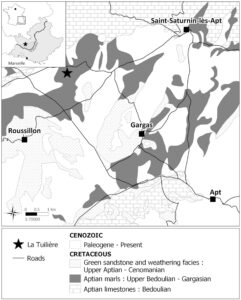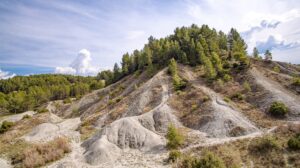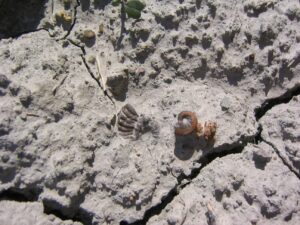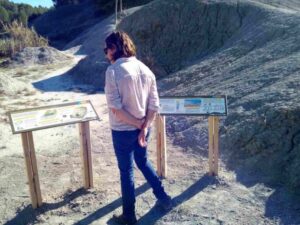Introduction
The gray marls cropping out around the town of Apt (Vaucluse, southern France) were proposed by Alcide d'Orbigny as the stratotype of the Aptian stage because of their rich and specific paleontological content (d’Orbigny 1840). Recent studies (Moullade et al. 2017) on ammonites, planktonic and benthic foraminifera and ostracods from La Tuilière provide details concerning both the dating of these rocks assigned from around the lower/upper Aptian boundary and paleoecology.
La Tuilière site is located in southeastern France, in the Luberon Regional Nature Park, recognized as a UNESCO Global Geopark (Luberon UGGp), in the municipality of Saint-Saturnin-lès-Apt (Fig. 1). It is one of the most fossiliferous outcrops still visible of the historical stratotypical area of the Aptian Stage. It consists of bad lands of gray marls with slopes that have been heavily gullied by run-off water erosion (Fig. 2). Since the 16th century, clays from these fossiliferous bad lands have been exploited for making tiles. Nowadays, they constitute a geosite protected and developed by the local authorities in partnership with the Luberon UGGp.

Figure 1. Geographical and geological setting of the Aptian marls of la Tuilière in the Luberon UNESCO Global Geopark (Sources: PNRL, BRGM, IGN - Author: M.Krebs 2020/10/14 – SIT PNR PACA – Luberon).

Figure 2. Aerial view of the Aptian marls of La Tuilière (photo by Philippe Clin).
Aptian marls, a Geosite of the Luberon UNESCO Global Geopark
The Aptian Stage was introduced by Alcide d'Orbigny in 1840. The definition provided by the author is very brief. After comments on the fauna of the upper part of the Neocomian, d'Orbigny adds: "On pourrait peut-être séparer entièrement cette faune et donner aux couches qui les renferment un nom spécial. Je propose celui d'aptiennes, les environs d'Apt en étant le principal siège" (“One could distinguish this fauna and give a special name to these layers. I propose the name of Aptian, as they outcrop in the surroundings of Apt”) (d’Orbigny 1840, p. 631).
The interpretation of the Aptian gave rise to much discussion about its upper and lower boundaries and some authors divided it into three sub-stages from localities in south-eastern France: Bedoulian (Toucas 1888), Gargasian (Kilian 1887) and Clansayesian (Breistroffer 1947). The Gargasian sub-stage corresponds to the historical Aptian Stage (Moullade et al. 2017). This view is not supported by ammonite experts (Reboulet et al. 2011; Bulot et al. 2014). In the International Geological Time Scale, the Aptian is divided into two substages (lower and upper) defined by the presence (lower) and absence (upper) of the ammonite family Deshayesitidae.
Since the description of the Aptian Stage by Alcide d'Orbigny, the historical stratotypical area has been largely urbanized. However, recent researches (Dutour 2005; Moullade et al. 2009a; Moullade, et al. 2009b; Frau et al. 2017) have provided the elements to establish a continuous composite section of the "Aptian Marls" (sensu d'Orbigny 1840) based on the main residual outcrops of the stratotypic area: the hamlet of La Tuilière, in Saint-Saturnin-lès-Apt (Moullade et al. 2017).

Figure 3. Ammonites naturally extracted from the Aptian marls of La Tuilière by erosion.
Many fossils appear in the marl outcrops (Fig. 3). Around thirty species of ammonites have been identified in La Tuilière area, enabling precise biostratigraphic calibration of these marls (Dutour 2005). Belemnite rostrums are very abundant at certain levels as well as gastropods and bivalves. These marls also provide deep-water solitary corals, echinoderms, brachiopods and shark teeth. Fourteen species of sharks have been described (Cappetta 1975) including two new species. Microfossils (ostracods and foraminifera) are abundant and diverse and allow the biozonation of these levels to be refined. Other recent research (Moullade et al. 2017) was conducted on a site located a few kilometers from La Tuilière, leading to a precise definition of the lower limit of the Gargasian Sub-Stage [= Aptian stage (i.e. sensu d'Orbigny 1840)].
Thus, the site of La Tuilière, as well as nearby sites, are of paleontological, stratigraphic and historical interest, which is always highlighted by active research. This interest has led the public authorities to support its conservation and promotion.
Discovering the Aptian marls
In the heart of the Luberon UGGp, the region of Apt is attractive because of the richness and diversity of its heritage: former ochre quarries, hilltop villages, mosaics of agricultural and forest landscapes. The marls of La Tuilière are one of those landscapes whose first visitors are the inhabitants. They are familiar with the site for its landscape and geological interest and have contributed to its protection.
The site is also visited by schools, which use it to provide support for National Education programs in the field. For senior high school students and more for university students, it is an appropriate place to study the succession of ammonite and belemnite faunas and to understand the biozonation of the series.
From an economic point of view, the site is open to the public free of charge. It constitutes an additional potential to enhance the Luberon territory interpretation within the Geopark's network of geosites, for the benefit of tourism professionals such as guides, hosts, etc.
In 2018, two on-site interpretation panels dealing with the particular geomorphology of marls, fossils, paleoecology, paleogeography and current biodiversity were set up (Fig. 4). They had been developed with contributions from the school children of the village and with the support of the Geopark and local authorities (Mehdi et al. 2019).
A signposted footpath provides access to the main site and a longer hiking loop has been defined on the "chemins des parcs" site. In each medium of discovery, whether physical or virtual, the interest and fragility of the site and the regulations in force are repeated.

Figure 4. Interpretation panels explaining the geological and ecological interest of the site of La Tuilière.
Conserving the Aptian marls
The first measure to protect the site was the extension in 1996 of the Luberon Geologic National Nature Reserve. This National Nature Reserve is managed by the Luberon Regional Nature Park. In the entire municipality of Saint-Saturnin-lès-Apt, the extraction of fossils and minerals is prohibited. However, this regulation was insufficient to face growing urbanization. Under the initiative of the Park, in partnership with the municipality and Vaucluse department, the Aptian marl site of La Tuilière has joined the network of the Espaces Naturels Sensibles (ENS) de Vaucluse (Sensitive Natural Spaces of Vaucluse). This label aims to ensure the conservation of natural sites and their discovery by the public. It is also a tool for implementing an effective land acquisition policy thanks to dedicated public funding. Today, the municipality owns the main site of the Aptian marls of La Tuilière and will be warned in the case of the sale of plots of scientific interest.
The management plan of the site is drawn up by the Luberon UGGp in partnership with the municipality and the department of Vaucluse. The goals for geological heritage conservation, and certain high-stake habitats, as well as the site's facilities for visitors, are detailed and evaluated annually.
Conclusion
The Aptian marls of La Tuilière consist of particular outcrops, testimony of the Aptian historical stratotype. Their paleontological, stratigraphic and ecological interest, as well as the mobilization of the public authorities, in partnership with the Luberon UGGp, have led to the creation of a protected area, un Espace Naturel Sensible du département de Vaucluse, a tool for the protection and valorization of natural areas in France. The management plan supports the promotion of scientific studies, awareness raising for local inhabitants about their heritage, the conservation of certain habitats and managing visitor numbers. The same approach could be carried out on other Aptian sites in the Apt area.
Conflict of Interest
The authors declare that they have no competing interest
Acknowledgments
The authors express sincere thanks to Christine Balme, the former curator of the National Geologic reserve of Luberon, who worked on the Aptian marls of La Tuilière protection and Michel Moullade for its contribution to the Aptian study in the Apt area.
